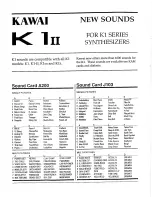
SAVE
S3000XL Operator’s Manual
Page 211
HARD DISK CONTROL
SCSI (Small Computer Serial Interface) has become very popular as a means of
interfacing devices and because a SCSI interface is fitted as standard on the S3000XL,
you may use a wide range of hard disks as a storage device for your sound library. Hard
disks offer more in the way of size and also speed. More recently, the removable cartridge
types of storage devices have become increasingly popular. The problem with fixed drives
is that when they fill up you either have to delete files (or back them up to floppy or DAT)
or you need to buy another drive. With the removable types, you simply insert another
cartridge.
Your hard disk is controlled from the
page of the SAVE mode. When
(F5) is
pressed, the following screen display is seen:
The parameters on this page are used to set SCSI ID’s. The most important parameters
you need to know about are
and
.
SCSI allows up to 8 devices to be on the buss and these each have a unique number 0-7
(it’s similar to the concept of MIDI channels). In order for one SCSI device to ‘talk’ to a
hard drive, their SCSI ID’s must match. The
field sets the SCSI ID for
the sampler’s SCSI interface. The default setting in the
field is 5. This
parameter must be set to match that of the drive. For example, if your external drive is 1,
this parameter must be set to 1. You may, if you wish, have several drives connected and
each of these must have different SCSI ID’s. Each one can be selected by changing the
ID number in the
field.
The
field allows you to switch between the different MO
formats of disk. There are two - 512Bytes per sector and 1kByte per sector. Both offer the
same storage, they just have different sector sizes. The S3000XL can use both and this is
selected in this field. The default is 512b.
The
field sets the S3000XL’s SCSI ID (as distinct from the sampler’s
SCSI interface’s ID) and is used when communicating between samplers or computer
editors over SCSI.
NOTE: If your external drive’s ID is something other than 5 and uses a IkBytes/sector disk,
you may set the appropriate settings here and, by saving the operating system to floppy
disk and powering up with it in the drive, the S3000XL will default to the SCSI ID and
sector size of your drive.














































